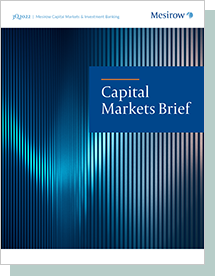Insights
3Q2022 Capital Markets Brief
Share this article
Introduction
The third quarter of 2022 has been one of persistent anxiety for investors, a global community that traditionally seeks, and rewards, stability. Decades-old norms for sovereign borders, political rectitude, price-efficient energy markets and politically modest central bank behavior have been overturned. Regular readers of this Brief will have been prepared for market volatility in 3Q22, as markets strain to price inflation, interest rate risk, global macro political risk and volatility/liquidity premia into their price structures. Investors got the full measure of those concerns in this quarter.
In a timely piece of research, the NY Fed paper (R**) presented on September 26th highlights the concept of financial instability potentially standing in the way of the Fed’s pursuit of the “natural real interest rate” after a long period of nominally low rates, as we have experienced. In layman’s terms, the paper theorizes that financial instability manifests itself before Fed interest rate moves raise rates to an inflation-neutral level.
This is not to bog our readers down in financial minutia, but to alert investors to this emerging structural phenomenon. Our readers know that we believe the actions of an overly accommodative Federal Reserve Board have distorted economic balance. The risks of reversing years of excess monetization and Fed balance sheet expansion have embedded risk into their use of traditional tightening (inflation fighting) disciplines. We believe that this R** is worthy of more focus from capital markets professionals.

The S&P 500 Index is a stock market index tracking the stock performance of 500 of the largest companies listed on stock exchanges in the United States and constructed to provide a comprehensive and unbiased barometer of the U.S. equity market.
The credit default swap index (CDX) is a financial instrument composed of a set of credit securities issued by North American or emerging market companies. Currently, the CDX contains 125 issuers and is broken down by two different types of credits: investment grade (IG) and high yield (HY).
A proprietary yield curve Municipal Market Data (MMD) AAA Curve provides the offer-side of AAA-rated state general obligation bonds (GO). The MMD analyst team determines the inclusion of bonds. The MMD AAA curve represents the MMD analyst team’s opinion of AAA valuation, based on an institutional block size of $2 million-plus market activity in both the primary and secondary municipal bond market. US Real Weekly Earnings Index is the weekly earnings of US employees, adjusted for inflation. They provide insight into what an average individual is earning per week and thus is the primary measure of wage growth in the United States.
An exchange traded fund (ETF) is a type of security that tracks an index, sector, commodity, or other asset, but which can be purchased or sold on a stock exchange the same as a regular stock.Mesirow refers to Mesirow Financial Holdings, Inc. and its divisions, subsidiaries and affiliates. The Mesirow name and logo are registered service marks of Mesirow Financial Holdings, Inc., © 2022, Mesirow Financial Holdings, Inc. All rights reserved. Mesirow does not provide legal or tax advice. Securities offered by Mesirow Financial, Inc. member FINRA, SIPC. Some information contained herein has been obtained from sources believed to be reliable, but is not necessarily complete and its accuracy cannot be guaranteed. Any opinions expressed are subject to change without notice. It should not be assumed that any his-torical market performance information discussed herein will equal such future performance. This report is for information purposes only, and should not be considered a solicitation to buy or sell any security.
Spark
Our quarterly email featuring insights on markets, sectors and investing in what matters
